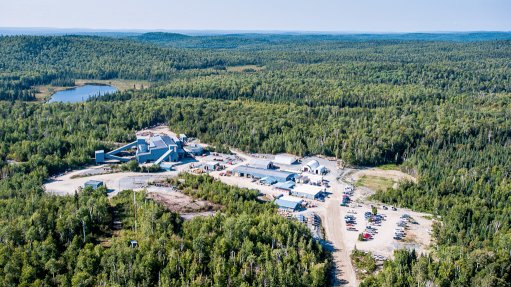
Photo by: Richmont Mines
TORONTO (miningweekly.com) – Canadian junior gold producer Richmont Mines on Tuesday announced that it would accelerate ramp construction to the 1.1-million-ounce inferred resource extension below the corporation's cornerstone Island Gold mine, in Ontario.
The TSX- and NYSE MKT-listed miner explained that it intended to ink a contract with underground mining contractor Manroc Developments to accelerate ramp development into the lower Island Gold zone, with work expected to start in mid-October.
Over the next 12 months, the contractor would be expected to extend the ramp from the current 635 m level to a depth of 660 m by year-end, and to a depth of 735 m by the end of November next year. This required 800 linear metres of ramp development.
The work would enable Richmont to prepare a second mining horizon by the end of 2015, on the 735 m level.
The company expected to complete developing the first mining horizon on the 635 m level by early next year.
In preparation for mining the first stopes in the lower resource, which was expected to take place at the end of 2014 and in early 2015, a ventilation raise and an escape way system from the 585 m level to the 390 m level would also be completed.
RESOURCE UPSIDE
Concurrent with ramp development, a 500 m drift to facilitate exploration/definition drilling would be driven to the east on the 620 m level, of which the company expected about 200 m to be completed this year.
As the drift progressed, 100 m of additional service, mucking, and drill bays would be completed. This drift would facilitate definition drilling to upgrade existing resources into reserves, in the eastern portion of the deposit, between depths of 500 m to 800 m, through 2015 and 2016, and would also allow more cost-effective underground drill testing of a number of unexplored and untested areas of the property, including down plunge to the east and at depth, both of which were open.
This 12-month contract, including the escape way extension, had an estimated cost of $10-million, $4-million of which would be spent this year. This would lift capital expenditures at Island Gold for this year from $16.4-million to $20.4-million.
"By accelerating the development of our current 1.1-million-ounce inferred resource, below our operating Island Gold mine, we expect to be in a position to start mining from our first stope in this lower zone by year-end. Exploration has excellent potential to further expand this resource at depth and along strike; however, our current development plan is the optimal path forward.
“We believe that, based on the resource and our projected development schedule, it could allow the annual production level of the mine to increase incrementally over the next three years,” interim president and CEO Elaine Ellingham said.
She added that Richmont expected to continue step-out exploration of the deposit along strike and at depth through 2015 and likely into 2016 to test the upside potential of the Island Gold deposit, which would help determine the longer-term possibilities of the mine.
Continuing development had enabled Richmont to access the upper portion of the higher-grade resource on the 535 m and 585 m levels of the mine.
Results from chip sampling on the face over 120 m of lateral development on the 535 m level averaged 12.68 g/t gold over an average width of 2.51 m. On the 585 m level, sampling over 125 m of lateral development averaged 6.89 g/t gold over an average width of 2.91 m.
These results were further to the chip sampling results obtained over 92 m of lateral development on the 560 m level of the mine that averaged 12.73 g/t gold over a 2.92 m width. The chip-sampling results corresponded well with the resource estimate and met the corporation's grade and continuity expectations, said Richmont.
HIGHER COSTS
The company also reported that a temporary portable crusher and conveyor had been installed at the Island mill, to be available while short-term repairs to the primary crusher were being completed, and replacement parts were being delivered.
Richmont added that this was not expected to impact third-quarter gold sales or operation cash cost, nor to impact the tonnage milled during the fourth quarter. However, the corporation did expect that during the period, while the repairs were being completed in the fourth quarter, cash operating costs an ounce at the Island Gold mine would be 5% to 10% higher.